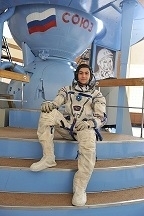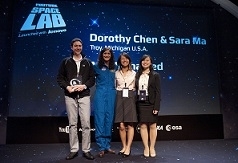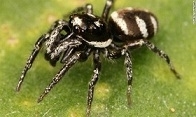 |
Can Jumping Spiders Attack Their Prey in Space? This was the name of an experiment that was carried out on the International Space Station on the year 2012 by Amr Mohamed the young Egyptian scientist Mohamed, 18 years old, raised up in Alexandria, showed an early passion for science since his very first years, When he was 12-13 he sat up a lab in his house that consisted of an old wooden packing box that he put shelves in, he also had a rack full of test tubes, a storage battery, and a microscope, he used to spend most of his time in his little lab watching things under the microscope mixing Chemicals and watching colors change.
 |
Mohamed was one of the two winning entries from around the world for the YouTube Space Lab competition, under supervision of Professor Stephen Hawking, who asked students to design experiments for space scientists. His searching journey on the internet brought him to space lab, Mohamed heard about the competition only 3 days before the deadline, so he designed a YouTube video of his idea in just one day, The idea behind his experiment was to study how the zebra spider, which jumps on its prey rather than building a web, will hunt when it is in zero gravity. Mohamed chose the Zebra Spider (Salticus Scenicus) which is a species of spiders that doesn't build a web and uses its four pairs of large eyes to locate prey and then jump to capture it. As for all spiders that have been in space they used to build webs to trap their prey, however Salticus Scenicus doesn't build webs. jumping spiders first locate their prey with their four large pairs of eyes then, they advance slowly towards their prey until they become at a reachable distance from them, then they jump on their prey and grab them with their jaws. Salticus Scenicus doesn't bother gravity, when it jumps off a wall it falls back on it just a few millimeters away instead of falling down on the ground and this is due to its lifeline, as before jumping the spider glues a silk thread from the jumping surface in case it missed the target it will climb up the thread and try again. The question here is whether the Salticus Scenicus will be able to catch its prey in Microgravity? Mohamed's hypothesis for this question was No. Mohamed expected that the spider will approach slowly from its prey and jump but instead of landing on the prey it will remain floating in space and it may use the lifeline to get back to its original position.
 |
Mohamed started writing the script then turned the camera on explained his experiment and the video was online before the day was over, Mohamed was announced as a regional finalist and after a week of public voting was invited to Washington DC as a regional winner to experience a zero-gravity flight. Mohamed and a two girl team were announced as global winners and their experiments will be performed in space at the international space station. He was the only one from the Middle East, Africa and Europe who reached the final stage at his age. The Missionary Spider was from a species called Phidippus johnsoni -known as the Redback jumping spider- it was named ''Nefertiti'' or ''Neffi'', It performed the experiment and spent 100 days in space, Neffi was of a species that had a lifespan of about one year It was 10 months old when it was sent to space. Unfortunately Neffi was announced dead by the Smithsonian's National Museum of Natural History.
Mohamed was influenced by the 25th of January Egyptian Revolution. He was very disappointed from the lack of opportunities offered to scientists before the revolution, and that Egypt wasn't contributing in many fields. On the 25th of January when thousands of Egyptians took the streets, it was his time to leave the lab and join his fellows. Mohamed started looking for things that he hated before the revolution had taken place and began to look for solutions. For months he couldn't find anything until one day he found his perfect opportunity: the You Tube Space Lab Competition, The Global Science Competition that gave him the chance to make his dream come true and to raise Egypt's name in the sky of science.
 |
Mohamed not only had the chance to see his idea come alive in space, also he and the other two winning girls will get to choose between one of two space experiences: either a trip to Japan to watch their experiment blast off in a rocket or an astronaut training experience in Star City, Russia. Mohamed had applied to join one of three of US's prestigious Universities: MIT, Stanford and Colombia, and he won the chance to study in Stanford University; he has decided to take science as a career. Mohamed also won two silver medals in programming in the Egyptian Olympiad for Informatics.
Page created on 5/27/2014 12:00:00 AM
Last edited 9/2/2018 3:35:37 PM
